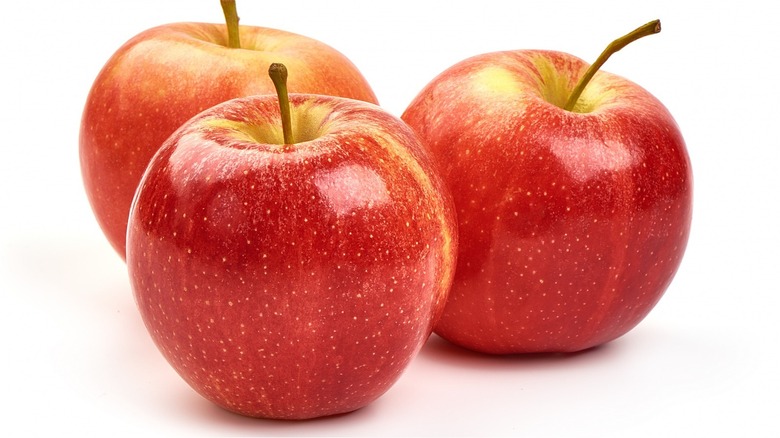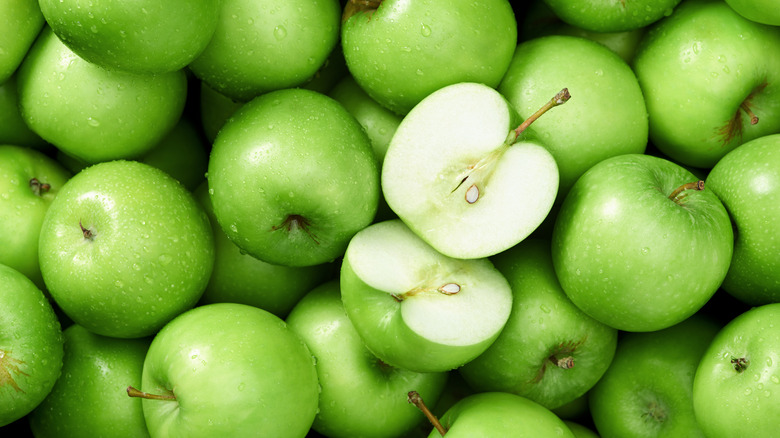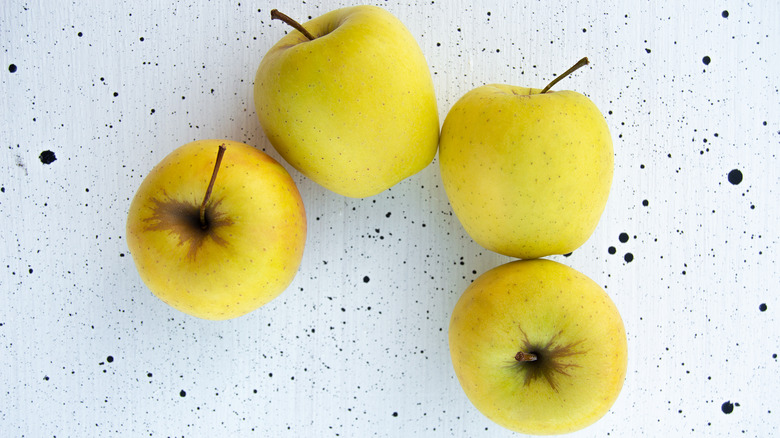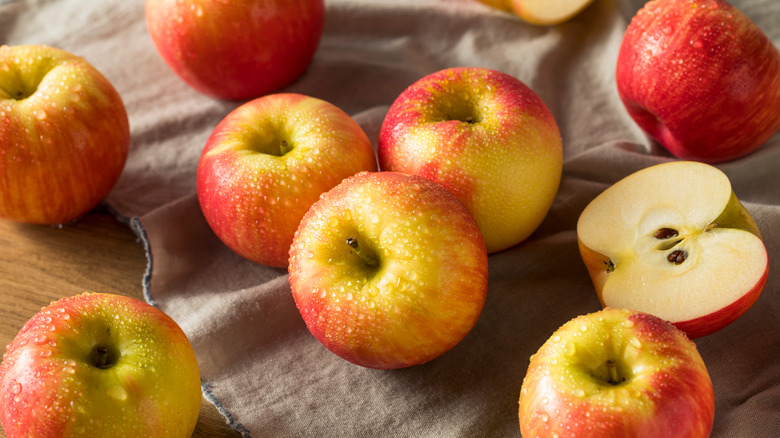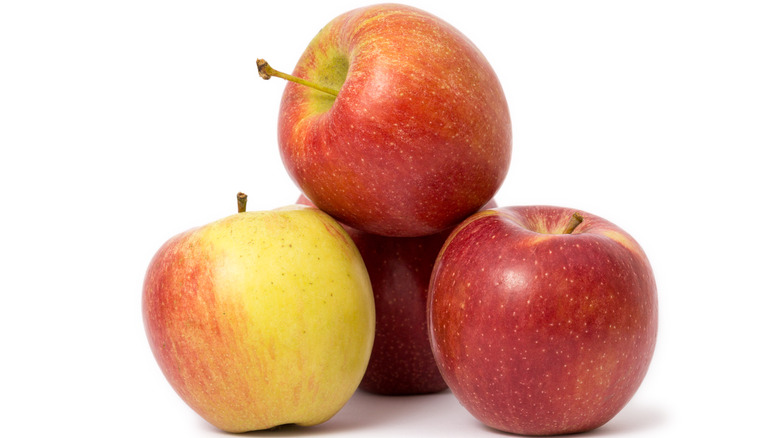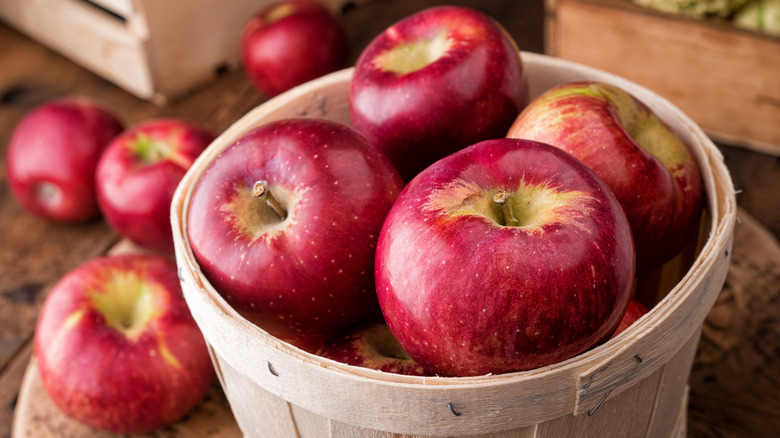The Best Types Of Apples For Baking And What To Make With Them
Apples are more than just juicy fruits that emit an audible crunch when bitten. They actually play a substantial role in American culture: New York City is the Big Apple. Rumor has it that, "An apple a day will keep the doctor away " and that the object of your affection is "the apple of your eye." Men have Adam's apples, someone is always "upsetting the apple cart," and it is said that there is nothing more American than an apple pie. And that's not all.
This commonplace fruit is highly beneficial to your health as it is not just high in dietary fiber, but also contains malic acid, something that can assist those who suffer from "fibromyalgia, chronic fatigue syndrome, and gallstones" (via Parlee Farms). It boasts some interesting claims to fame. For instance, there is an actual apple phobia called "Malusdomesticaphobia," apples and roses belong to the same family, and pomology is the study of growing apples (per Apple Holler). Interestingly, Apples From New York reveals that these stemmed orbs are 1/4 air, which explains why they can float — and humans can easily bob for them. And USApple shares that this nation grows over 100 different types of apples alone.
Most people would be hard-pressed to name a dozen different apple varieties, let alone 100. With so many to choose from, bakers are left with just one question. What is the best type of apple for baking?
Granny Smith
For many, the number one choice when it comes to a good baking apple is the trusty Granny Smith. Why is it so popular? Bon Appétit calls it their "go to apple" as it maintains its structure even after prolonged exposure to oven heat. Country Living agrees, saying that it is perfect for high-quality apple pies as Granny Smiths keep their shape and don't transform into mush. And Ree Drummond, the master of all-things-rustic-and-wholesome, agrees, saying that these green beauties are her favorite for making apple pies, adding that they are also readily available 12 months of the year.
There are, however, a few caveats to remember when working with the Granny Smith. For one thing, this is a tart apple variety. In order to counterbalance this tartness, you will need to add extra sugar into your pie filling (via Food Network). But, on the flip side, Taste of Home contends that the sharp flavor of the Granny Smith works in an apple crisp as its tartness goes well with the sugary topping. Yes, this apple type is perfect for those who think a little sweetness goes a long way. Kitchn warns, however, that it is best to peel this variety as the light green skin can turn a pretty dessert into something unsightly.
Clearly, the Granny Smith has a great deal to offer anyone whipping up an apple-based dish, but works particularly well in crisps, pies, and tarts (which are really just little pies, after all).
Golden Delicious
Anything with the word "delicious" built right into its name has got to have some pretty admirable qualities. The Golden Delicious apple possesses several great traits that make it not just a great apple to sink your teeth into, but a great baking ingredient as well.
While its red and also "delicious" counterpart, the well-known Red Delicious Apple, doesn't hold up well to baking, the Golden variety does. The Food Network praises this apple's ability to maintain its shape in a pie or apple crisp, but warns that it has a very subtle flavor. They recommend pairing it with a Braeburn apple, while Martha Stewart offers that it would go great in a pie mixed with Granny Smiths. The Pioneer Woman says the Golden Delicious will be splendid in a pie that is heavy on sugar and spices. Finally, you have a reason to add some extra cinnamon and nutmeg.
In an interesting twist, the CBC says that this apple's mild flavor is actually a huge plus, making it an ideal choice for both "sweet and savory" dishes.
Honeycrisp
Aptly named the "Honeycrisp" apple, this variety is both sweet like honey and extra crispy. This newcomer to the apple realm (it first became readily available in the 1990's) hails from what is now "the most widely planted type of apple tree in the country" (via Food Network). It has clearly become a favorite amongst apple munchers and bakers, alike, and even sparked a Honeycrisp apple Twitter feud. Not many apples can say that.
Why is it so popular among the baking crowd? This apple is one of the firmest available, and the firmer the apple, the better it holds up to baking. And, unlike the crisp Granny Smith, it is sweet instead of tart. Country Living enthuses that this variety won't devolve into apple-flavored slush. Ree Drummond is a huge fan, praising their ability to retain their shape and consistency while adding that they make a perfect pie that won't be watery. And Kitchn says that they are plentiful and easy to find at most supermarkets, making them a great go-to baking apple. In fact, they are extremely versatile as they are a great choice for pies, tarts, dumplings, and bars (per Betty Crocker). And, of course, eating just as they are.
This must be why Bon Appétit has a penchant for this particular apple type, lovingly referring to it as their "desert-island apple."
Braeburn
Sometimes an apple is simply blessed with good genes. The Braeburn is one of these lucky few. This pretty apple of red and gold boasts a respectable lineage, hailing from the same family tree as the Lady Hamilton and Granny Smith varieties (per Insider). And, when it comes to baking, this apple seems to possess all the right stuff.
What sets the Braeburn apart from many is its taste and its ability to keep its firmness. Bon Appétit contends that its intense flavor will let it "stand up to a boatload of cinnamon," while the Food Network offers that its "strong apple flavor doesn't need another apple to balance the flavor in a pie." This little number will enable you to showcase both the apple-ish taste and the spices in your next apple pie. Clearly, its flavor is top-notch, but what about its crispness? The Pioneer Woman says that these are great baking apples as they "release very little liquid." So, no, your baked goods will not be mushy. And, as an added bonus, their colorful exterior does make them and the things you make withcinmmmmm them awfully attractive.
Cortland
While the Cortland is a relative of the McIntosh variety — an apple that doesn't hold up well to heat, per Recipes 4 All Days — don't let that fool you. This juicy little number is great for baking. After all, Kitchn says that while it's not as firm as some of the other contenders, it is able to maintain its shape and consistency quite well. And, when it comes to the Cortland, it offers a unique benefit not offered by any of its relations on this list.
What is this outstanding feature? Cortlands aren't quick to turn brown! Yes, according to CBC, this variety holds onto its white hue when cut, which is a great feature when you're using a bushel's worth. Plus, Country Living contends that this apple stands up well to freezing, meaning you can make desserts by the dozen should the mood hit. But how do they taste? The Food Network says that the Cortland has a perfect blend of sharpness and sweetness, making it the star of your apple pies and old-fashioned apple crisp recipes. There's no need to add another apple when you have a Cortland on hand. One caveat, however, is that the best time to find this variety is during the fall months (per The Pioneer Woman).
